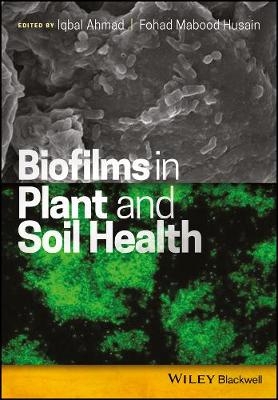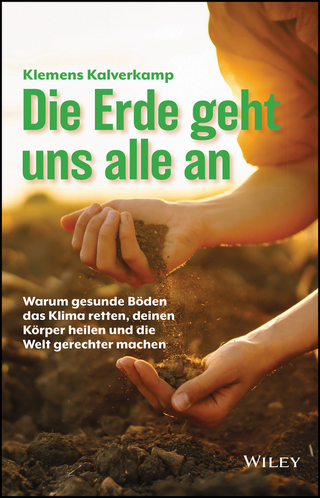
Biofilms in Plant and Soil Health
Wiley-Blackwell (Verlag)
978-1-119-24634-3 (ISBN)
- Titel z.Zt. nicht lieferbar
- Versandkostenfrei
- Auch auf Rechnung
- Artikel merken
Written by leading experts from around the world, Biofilms in Plant and Soil Health provides an up-to-date review on various aspects of microbial biofilms, and suggests future and emerging trends in biofilms in plant and soil health.
Issues are addressed in four sub areas:
I) The fundamentals and significance of biofilm in plant and soil health, and the concept of mono and mixed biofilms by PGPR and fungal biofilms.
II) Biochemical and molecular mechanisms in biofilm studies in plant associated bacteria, and techniques in studying biofilms and their characterization, gene expression and enhanced antimicrobial resistance in biofilms, as well as biotic and biotic factors affecting biofilm in vitro.
III) The ecological significance of soil associated biofilms and stress management and bioremediation of contaminated soils and degraded ecosystems.
IV) Pathogenic biofilm associated with plant and food and its control measures.
This book is recommended for students and researchers working in agricultural and environmental microbiology, biotechnology, soil sciences, soil and plant health and plant protection. Researchers working in the area of quorum sensing, biofilm applications, and understanding microbiome of soil and plants will also find it useful.
About the Editors Iqbal Ahmad is a Professor in the Department of Agricultural Microbiology, Aligarh Muslim University, Aligarh, India and former visiting Professor, Department of Biology, Umm Al-Qura University, Makkah, Saudia Arabia. Fohad Mabood Husain is a Post-doctoral Researcher in the Department of Food Science and Nutrition, King Saud University, Saudi Arabia.
Preface xviii
List of Contributors xx
1 Biofilms: An Overview of Their Significance in Plant and Soil Health 1
Iqbal Ahmad, Mohammad Shavez Khan, Mohd Musheer Altaf, Faizan Abul Qais, Firoz Ahmad Ansari and Kendra P. Rumbaugh
1.1 Introduction 1
1.2 Biofilm Associated with Plants 3
1.3 Biofilm Formation Mechanisms: Recent Update on Key Factors 4
1.4 Biofilm in Soil and Rhizospheres 7
1.5 Genetic Exchange in Biofilms 7
1.6 Diversity and Function of Soil Biofilms 8
1.7 The Role of Biofilms in Competitive Colonization by PGPR 8
1.8 Biofilm Synergy in Soil and Environmental Microbes 9
1.9 Biofilms in Drought Stress Management 10
1.10 Plant Health and Biofilm 10
1.11 How Microbial Biofilms Influence Plant Health? 10
1.12 Soil Health and Biofilms 12
1.13 How to Assess Soil Health? 13
1.14 Impact of Biofilms on Soil Health 14
1.15 Biofilm EPS in Soil Health 14
1.16 Conclusions and Future Directions 15
References 15
2 Role of PGPR in Biofilm Formations and Its Importance in Plant Health 27
Govind Gupta, Sunil Kumar Snehi and Vinod Singh
2.1 Introduction 27
2.2 Rhizosphere: A Unique Source of Microorganisms for Plant Growth Promotion 27
2.3 Plant Growth–Promoting Rhizobacteria 28
2.4 Biofilm Producing Plant Growth–Promoting Rhizobacteria 34
2.5 Role of PGPR in Biofilm Formations 35
2.6 Future Research and Development Strategies for Biofilm Producing Sustainable Technology 35
2.7 Conclusions 36
Acknowledgments 36
References 36
3 Concept of Mono and Mixed Biofilms and Their Role in Soil and in Plant Association 43
Janaína J. de V. Cavalcante, Alexander M. Cardoso and Vânia L. Muniz de Pádua
3.1 Introduction 43
3.2 Soil- and Plant-Associated Biofilms 45
3.3 Microbial Signaling, Regulation, and Quorum Sensing 46
3.4 Biotechnology 48
3.5 Outlook 49
Acknowledgments 49
References 49
4 Bacillus Biofilms and Their Role in Plant Health 55
Mohd Musheer Altaf, Iqbal Ahmad, Mohd Sajjad Ahmad Khan and Elisabeth Grohmann
4.1 Introduction 55
4.2 Interaction of Bacillus within Plant Rhizosphere and Biofilm Development 57
4.3 Multispecies Biofilms and Their Significance 59
4.4 Biofilm Detection and Characterization 60
4.5 Bacillus Biofilm and Plant Health Promotion 60
4.6 Conclusion and Future Prospects 62
References 63
5 Biofilm Formation by Pseudomonas spp. and Their Significance as a Biocontrol Agent 69
Zaki A. Siddiqui and Masudulla Khan
5.1 Introduction 69
5.2 Biofilms 79
5.3 Mechanisms of Biofilm Formation 81
5.4 Metabolites Affecting Biofilm Formation 84
5.5 Biofilm Formation and Biological Control of Plant Diseases 84
5.6 Conclusion 85
References 86
6 Quorum Sensing Mechanisms in Rhizosphere Biofilms 99
Jorge Barriuso
6.1 Background 99
6.2 QS in Biofilms Formation 101
6.3 Conclusions 106
References 107
7 Biofilm Formation and Quorum Sensing in Rhizosphere 111
Kusum Harjai and Neha Sabharwal
7.1 Introduction 111
7.2 Importance of Rhizosphere 111
7.3 Constituents of Rhizosphere 112
7.4 Communication in Rhizosphere 113
7.6 Quorum Sensing in Pseudomonads 118
7.7 Biofilm Formation in Rhizosphere 120
7.8 Conclusions 124
References 124
8 The Significance of Fungal Biofilms in Association with Plants and Soils 131
Michael W. Harding, Lyriam L.R. Marques, Bryon Shore and G.C. Daniels
8.1 Introduction 131
8.2 What Is a Biofilm? 132
8.3 Where Do We Find Filamentous Fungal Biofilms? 132
8.4 Fungal Biofilms: What Have We Learned from the Budding Yeasts? 133
8.5 What Does a Filamentous Fungal Biofilm Look Like? 134
8.6 Examples of Filamentous Fungal Biofilms 136
8.7 Examples of Fungal Biofilms in Soils and the Rhizosphere 139
8.8 The Mycorhizosphere 141
8.9 A Biofilm Approach to Plant Disease Management 141
References 143
9 Chemical Nature of Biofilm Matrix and Its Significance 151
Mohd Sajjad Ahmad Khan, Mohd Musheer Altaf and Iqbal Ahmad
9.1 Introduction 151
9.2 Structural Composition of EPS 154
9.3 Properties of Matrices 160
9.4 Functions of the Extracellular Polymer Matrix: The Role of Matrix in Biofilm Biology 162
9.5 Conclusion 168
Acknowledgments 168
References 169
10 Root Exudates: Composition and Impact on Plant–Microbe Interaction 179
Shamsul Hayat, Ahmad Faraz and Mohammad Faizan
10.1 Introduction 179
10.2 Chemical Composition of Root Exudates and Their Significance 180
10.3 Root Exudates in Mediating Plant–Microbe Interaction in Rhizosphere (Negative and Positive Interactions) 180
10.4 Direct and Indirect Effect of Root Exudates on PGPR, Root Colonization, and in Stress Tolerance 182
10.5 Role of Root Exudates in Biofilm Formation by PGPR 185
10.6 Role of Root Exudates in Protecting Plants Pathogenic Biofilm, Quorum Sensing Inhibition 186
10.7 Isolation of Root Exudates 187
10.8 Conclusion 188
References 189
11 Biochemical and Molecular Mechanisms in Biofilm Formation of Plant- Associated Bacteria 195
Alwar Ramanujam Padmavathi, Dhamodharan Bakkiyaraj and Shunmugiah Karutha Pandian
11.1 Introduction 195
11.2 Plant-Associated Bacteria 196
11.3 Biofilms and Plant Pathogens 196
11.4 Molecular and Biochemical Mechanisms Involved in Biofilm Formation 197
11.5 Conclusion 205
References 205
12 Techniques in Studying Biofilms and Their Characterization: Microscopy to Advanced Imaging System in vitro and in situ 215
Elisabeth Grohmann and Ankita Vaishampayan
12.1 Introduction 215
12.2 Classical Techniques to Study Biofilms 216
12.3 The Gold Standard: Flow-Cell Technology and Confocal Laser Scanning Microscopy (CLSM) 218
12.4 The Biofilm Flow Cell 218
12.5 Advanced Digital Analysis of Confocal Microscopy Images 221
12.6 Biofilm Studies at Different Scales 222
12.7 Conclusions and Perspectives 224
Acknowledgments 225
References 225
13 Gene Expression and Enhanced Antimicrobial Resistance in Biofilms 231
Daniel Padilla-Chacón, Israel Castillo-Juárez, Naybi Muñoz-Cazares and Rodolfo García-Contreras
13.1 Introduction 231
13.2 Biofilms in the Plant–Microbe Relationship 232
13.3 Stress Induces Biofilm Formation 236
13.4 Relevance for Bacterial-Associated Plants 237
13.5 Enhanced Antimicrobial Resistance in Biofilms Is Mediated by Biofilm Physicochemical Characteristics and Specific Changes in Gene Expression 237
13.6 Potential for Implementing Antibiofilm Strategies to Protect Crops 239
13.6 Conclusions 244
Acknowledgments 244
References 244
14 In Vitro Assessment of Biofilm Formation by Soil- and Plant-Associated Microorganisms 253
Michael W. Harding and G.C. Daniels
14.1 Introduction 253
14.2 How to Make a Biofilm 254
14.3 What Is the Best Way to Make a Biofilm in Vitro? 254
14.4 Flow Systems 255
14.5 Static Reactors 261
14.6 Special Considerations for Filamentous Fungal Biofilms 265
14.7 Biofilm Reactors Used to Characterize Plant-Associated Biofilms 266
14.8 Value-Added Products from Biofilm Reactors 266
References 267
15 Factors Affecting Biofilm Formation in in vitro and in the Rhizosphere 275
Firoz Ahmad Ansari, Huma Jafri, Iqbal Ahmad and Hussein H Abulreesh
15.1 Introduction 275
15.2 Process of Biofilm Formation 276
15.3 Factor Influencing Biofilm Formation 278
15.4 Conclusions and Future Direction 285
References 286
16 Ecological Significance of Soil-Associated Plant Growth–Promoting Biofilm- Forming Microbes for Stress Management 291
Arpita Singh and Puneet Singh Chauhan
16.1 Introduction 291
16.2 Rhizosphere Hub of Plant–Microbe Interactions 292
16.3 Commencement of Rhizosphere Effect and Bacterial Colonization by Root Exudates 293
16.4 Quorum Sensing as a Way of Interaction between Bacteria and Host Plant 295
16.5 Biofilms 296
16.6 Effects of Stress on Plants 302
16.7 Stress Tolerance in Plants 309
16.8 Conclusion 316
16.9 Future Perspectives 317
Acknowledgments 317
List of Abbreviations 317
References 318
17 Developed Biofilm-Based Microbial Ameliorators for Remediating Degraded Agroecosystems and the Environment 327
G. Seneviratne, P.C. Wijepala and K.P.N.K. Chandrasiri
17.1 Introduction 327
17.2 Developed Microbial Communities as a Potential Tool to Regenerate Degraded Agroecosystems 328
17.3 Biochemistry of Fungal-Bacterial Biofilms 330
17.4 Endophytic Microbial Colonization with the Application of Fungal- Bacterial Biofilms 330
17.5 Biofilm Biofertilizers for Restoration of Conventional Agroecosystems 331
17.6 Developed Microbial Biofilms for Environmental Bioremediation 331
17.7 Conclusion 333
References 333
18 Plant Root–Associated Biofilms in Bioremediation 337
Sadaf Kalam, Anirban Basu and Sravani Ankati
18.1 Introduction 337
18.2 Biofilms: Definition and Biochemical Composition 337
18.3 Bioremediation and Its Significance 338
18.4 Root-Associated Biofilms 340
18.5 Bioremediation of Contaminants in Rhizospheric Soils 344
18.6 Implications of Rhizospheric Biofilm Formation on Bioremediation 347
18.7 Conclusion and Future Prospects 348
Acknowledgments 349
References 349
19 Biofilms for Remediation of Xenobiotic Hydrocarbons—A Technical Review 357
John Pichtel
19.1 Introduction 357
19.2 Polycyclic Aromatic Hydrocarbons 359
19.3 Chlorinated Ethanes, Ethenes, and Aromatics 364
19.4 Chlorinated Aromatics 369
19.5 Polychlorinated Biphenyls (PCBs) 371
19.6 Polychlorinated Dibenzodioxins 374
19.7 Conclusions 375
References 375
20 Plant Pathogenic Bacteria: Role of Quorum Sensing and Biofilm in Disease Development 387
Deepak Dwivedi, Mayuri Khare, Himani Chaturvedi and Vinod Singh
20.1 Introduction 387
20.2 Mechanism of Biofilm Formation 388
20.3 Quorum Sensing Mechanism 391
20.4 Plant Pathogenic Bacteria Diversity and Plant Diseases 395
20.5 Blocking Quorum Sensing and Virulence in Combating Phytopathogen 395
20.6 Conclusion 400
References 400
21 Biofilm Instigation of Plant Pathogenic Bacteria and Its Control Measures 409
A. Robert Antony, R. Janani and V. Rajesh Kannan
21.1 Introduction 409
21.2 Plant Pathogens 409
21.3 Plant Physiological Alteration by Plant Pathogens 412
21.4 Virulence Strategies of Plant Pathogenic Bacteria 413
21.5 Biofilm Formations 414
21.6 Biofilm Controlling Strategies in Plant Pathogens 419
21.7 Main Targets and Some Potential Tools to Modify Biofilms 420
21.8 Physical Tools for Modifying Biofilms 421
21.9 Chemical Methods 425
21.10 Biological Methods 426
21.11 Future Prospects of Antibiofilm 429
21.12 Conclusion 430
References 430
22 Applications of Biofilm and Quorum Sensing Inhibitors in Food Protection and Safety 439
Ashraf A. Khan, John B. Sutherland, Mohammad Shavez Khan, Abdullah S. Althubiani and Iqbal Ahmad
22.1 Introduction 439
22.2 Biofilm Formation by Foodborne Pathogens 439
22.3 Significance of Biofilms in Food and Food Environments 440
22.4 Biofilm Control Strategies in the Food Industry 441
22.5 Natural Products as Antibiofilm Agents and Their Potential Applications 446
22.6 Role of QS Inhibitors in Biofilm Control 449
22.7 Conclusions 451
Acknowledgments 451
References 451
23 Biofilm Inhibition by Natural Products of Marine Origin and Their Environmental Applications 465
Alwar Ramanujam Padmavathi, Dhamodharan Bakkiyaraj and Shunmugiah Karutha Pandian
23.1 Introduction 465
23.2 Unity Is Strength: Benefits of Biofilm Formers 466
23.3 Transition of Slimy Film to Persistent Biofilm 467
23.4 Biofilm-Related Infections in Plants 467
23.5 Need for Antibiofilm Agents 467
23.6 Natural Products of Marine Origin as Antibiofilm Agents 469
23.7 Semi-synthetic Antibiofilm Agents Inspired by Marine Natural Products 469
23.8 Environmental Applications of Antibiofilm Agents 469
23.9 Conclusion 472
References 472
24 Plant-Associated Biofilms Formed by Enteric Bacterial Pathogens and Their Significance 479
Meenu Maheshwari, Mohammad Shavez Khan, Iqbal Ahmad, Ashraf A. Khan, John B. Sutherland and Abdullah S. Althubiani
24.1 Introduction 479
24.2 Enteric Pathogens in the Plant Environment 480
24.3 Colonization and Biofilm Formation by Enteric Bacteria on Plant Surfaces 483
24.4 Biofilm Regulation in Enteric Bacteria 484
24.5 Influence of Plant Defense on Survival and Biofilm Formation by Enteropathogens 485
24.6 Plant-Associated Enteric Bacteria in Food Safety and Human Health 486
24.7 Conclusions 487
References 487
25 Anti-QS/Anti-Biofilm Agents in Controlling Bacterial Disease: An in silico Approach 497
K. Ahmad, M.H. Baig, Fohad Mabood Husain, Iqbal Ahmad, M.E. Khan, M. Oves, Inho Choi and Nasser Abdulatif Al-Shabib
25.1 Introduction 497
25.2 Biofilm and Its Significance 498
25.3 Bioinformatics Approaches in Drug Target Identification and Drug Discovery 500
25.4 Target Identification Using in silico Technologies 500
25.5 Data Resources for Drug Target Identification 501
25.6 Homology Modeling 501
25.7 Docking 502
25.8 Virtual Screening 503
25.9 Application of Bioinformatics in Development of Anti-QS/anti-biofilm Agents 503
25.10 Virtual Screening for Identification of QS Inhibitors 505
25.11 Conclusion 507
References 507
Index 513
| Erscheinungsdatum | 10.10.2017 |
|---|---|
| Verlagsort | Hoboken |
| Sprache | englisch |
| Maße | 170 x 246 mm |
| Gewicht | 1134 g |
| Themenwelt | Naturwissenschaften ► Biologie |
| Weitere Fachgebiete ► Land- / Forstwirtschaft / Fischerei | |
| ISBN-10 | 1-119-24634-2 / 1119246342 |
| ISBN-13 | 978-1-119-24634-3 / 9781119246343 |
| Zustand | Neuware |
| Informationen gemäß Produktsicherheitsverordnung (GPSR) | |
| Haben Sie eine Frage zum Produkt? |
aus dem Bereich


